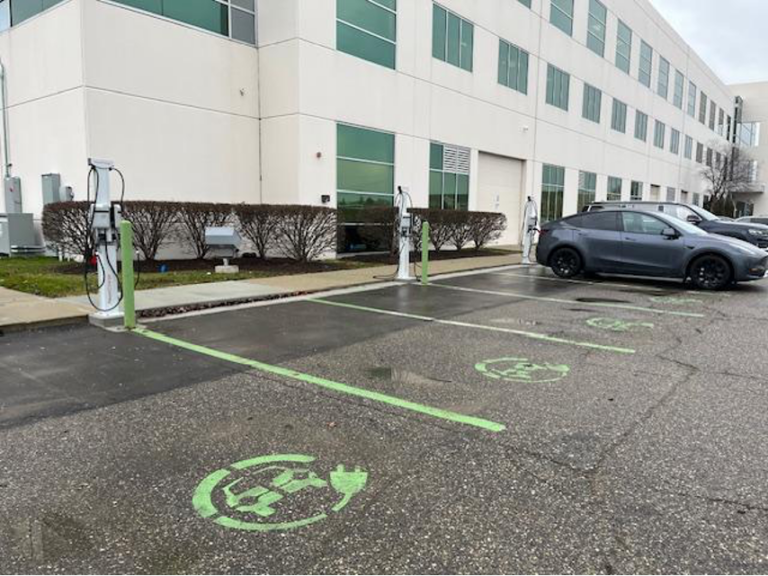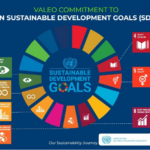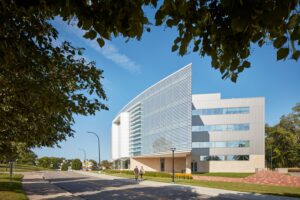
- Kim Kisner
- Business
- 01/23/2024
Plan Pillars Include Innovation, Environmental Eco-efficiency, Employees and Society

In 2021, global automotive supplier Valeo committed to reaching carbon neutrality by 2050. With $21 billion in sales and 109,900 employees in 29 countries, Valeo has a presence in Troy, Auburn Hills, and Highland Park.
SBN Detroit interviewed Valeo Group CAP50 Director Zobeida Gutierrez about the company’s sustainability efforts globally and its impact on Southeast Michigan.

Q: Tell us about the CAP50 project.
A: Championed by CEO and President Christophe Périllat, Valeo’s global decarbonization plan primarily focuses on 156 production plants. However, our actions extend to our design centers and Valeo Service activities around the world. I have worked for Valeo for thirty years in a variety of positions, including roles in quality in operations, supplier quality, project management, and special projects.
I am now the global lead for Valeo’s CAP50 decarbonization plan, and I support other sustainability and circular economy initiatives within North America.
Q: What are the specifics of the plan?
A: This is our action plan to contribute to carbon neutrality by 2050 across the entire Valeo value chain.
Valeo has set 2030 near-term CO2 reduction targets validated by SBTi (Science Based Target initiative) Scope 1 and 2 CO2 emission absolute value reduction of 75% and Scope 3 upstream and downstream reduction of 15% from our 2019 baseline.
This goal translates to removing 8.1 million metric tons of greenhouse gas emissions by 2030. Since 2019, we have removed 4.4 million metric tons as of the end of 2022, confirming the effectiveness of our CAP 50 plan.
The second reduction target integrates benefits realized from electrification within our product portfolio, accounting for a 45% CO2 emission reduction due to avoided emissions at third parties as compared to the 2019 CO2 emissions footprint baseline.
Q: What actions are you taking to achieve this?
A: Our framework includes all three scopes as well as greenhouse gas emissions.
Scope 1 targets direct emissions coming from our operations. We are currently investing to get our top 100 CO2 emitting sites Energy Management ISO 50001 certified to ensure they are focusing on energy efficiency to drive a 30% reduction in energy consumption by 2030. We are also switching to LED lights, eliminating fuel, oil, and natural gas use, installing solar panels at our sites, and introducing energy-efficient equipment.
Scope 2 focuses on indirect greenhouse gas emissions incurred by our energy suppliers. Our low-carbon electricity procurement supports the increase of renewable energy capacity projects. Our internal target is to secure 50% of energy coming from renewable sources by 2025 and 80% by 2030. Valeo has committed to investing $436 million to support Scope 1 and Scope 2 actions.
Scope 3 involves indirect greenhouse gas emissions within our supply chain, upstream and downstream.
Upstream efforts target indirect emissions incurred by our suppliers, and downstream efforts target indirect emissions incurred by the use and end-of-life of our products.
For Scope 3 upstream, we launched a sustainability assessment questionnaire to evaluate our supply chain sustainability maturity level. We also align our suppliers’ greenhouse gas emissions targets with ours – a reduction of 75% for Scope 1 and Scope 2 and 15% for Scope 3 Upstream emissions vs. their baseline year. Our suppliers are also required to cascade these targets throughout their entire supply chain.
Our transportation levers within Scope 3 include greener fuels, optimization of filling rates for trucks, multimodal scenarios such as replacing airfreight with train or truck, and the use of returnable and greener packaging.
For Scope 3 downstream, Valeo is accelerating its technological roadmap and cementing its global leadership in the electrification market. Currently, 60% of our portfolio supports EVs. We are researching and validating greener materials and designing more energy-efficient, lighter, and greener products.
No reduction in greenhouse gas emissions is too small. Every Ton of CO2 reduced counts. Even if it’s simply balancing HVAC systems in our buildings to save energy, simple things can add up to several tons of CO2 emissions reductions.
Q: How is your team structured to support the goals and initiatives?
A: It starts at the top. Our board of directors has set targets and reviewed achievements related to sustainability and climate change since 2016. In addition, since 2020, a director has been responsible for monitoring corporate social responsibility issues.
The Chief Sustainability Officer position within Valeo aligns with the Corporate Vice President of Sustainable Development and External Affairs, who works in partnership with the Chief Technology Officer and Vice President of Strategy. Sustainability topics are therefore under the direct oversight and management of the CEO.
Our human resources, health, safety, and environmental, ethics and compliance, research and development, and operations departments (purchasing, quality, projects, industrial) all contribute to Valeo’s sustainable development policy, and each business group assigns CAP 50 champions.
Q: What are your biggest challenges?
A: Our biggest concern – which is not unique to Valeo – is the lack of renewable energy capacity. The world needs to triple global renewable capacity from 2022 levels by 2030, which must reach 11,000 gigawatts in line with the International Energy Agency’s net zero emissions by 2050 scenario.
Also, there is a need for stronger domestic policies and international support, most notably in clean energy investment in emerging and developing economies.
Q: What are the biggest opportunities?
A: Electrification acceleration. The introduction of electric vehicles is an opportunity, not only for cars but also for micromobility.
Another opportunity is preserving our resources by creating a circular economy. Valeo has created the 4R Circle, which is our plan for Robust Design, Remanufacturing, Repair, and Recycling aimed at reducing the use of raw materials and preserving the planet’s resources by giving our products extended life and recyclability options.
Q: How is the work you are doing impacting Southeast Michigan?
A: In June 2022, we signed a contract with energy supplier DTE Energy to contribute 100% of renewable energy usage at our Michigan locations (Troy, Auburn Hills, and Highland Park) starting in April 2024. This contract is for 20 years, and it demonstrates Valeo’s commitment to supporting renewable energy projects in Michigan.
We have also implemented LED lighting in all of our Michigan buildings, including parking lot LED lighting at our Auburn Hills location.
We installed EV charging stations in Troy and Auburn Hills to support employees as they transition to the use of EVs.
Our actions are not limited to our sites as Valeo is also focusing on partnerships within the Detroit-area automotive ecosystem.
For example, we are partnering with Applied Intuition, a vehicle software supplier with an office in Royal Oak, to help automakers bring safe and reliable Autonomous Driver Assistance System (ADAS) features to market faster.
We also work with local universities to bring students in for apprenticeships and to collaborate on research projects.We are a proud member of the Institute for Advanced Composites Manufacturing Innovation, also known as the Composites Institute, which is located in Detroit, to collaborate on research of greener materials that will support our CO2 emissions reduction journey.
Q: What does the future look like when it comes to sustainability, climate change, and Valeo’s impact?
A: Our future is bright. Valeo has committed to seven of the United Nations Sustainable Development Goals (SDGs), and we have been working on sustainability for many years now.
We have a clear sustainability plan supported by four pillars: innovation, environmental eco-efficiency, employees, and society.
Four megatrends are driving Valeo’s growth aligned with the SDGs: Electrification acceleration, ADAS acceleration, reinvention of the vehicle interior experience, and lighting everywhere.
Thanks to our CAP 50 Plan, Valeo has met its SBTi greenhouse gas emissions targets in the past three years, and we expect future success, despite the challenges ahead of us.
Our circular economy and 4R (remanufacturing, robust design, recycle, repair) plans are key levers to reduce CO2 emissions and resource consumption.
We are among the most represented auto supplier companies in environmental, social, and governance indexes like Euronext CAC 40 ESG, CAC 40 SBT 1.5 C, STOOX Global ESG Leaders, and MSCI SEG Leaders, to name a few. When we speak about climate, we are a proud CDP ‘A’ score organization. The future will bring challenges but also opportunities to do our part to promote sustainability within our business and for our planet. We owe it to future generations.
Be sure to subscribe to our newsletter for regular updates on sustainable business practices in and around Detroit.
Kim Kisner
- All
- Business
- Community
- Education
- Events

ZF Group, a global technology company with its North American headquarters in Northville, specializes in systems for passenger cars, commercial vehicles, and industrial technology. With a focus on next-generation mobility, the company develops solutions that address electrification, automation, and digitalization while aiming to improve safety, efficiency, and sustainability in transportation. SBN Detroit interviewed Anuj Shah, Sustainability Lead, for the Americas, to explore the most pressing environmental challenges in...

The Chip Bag Project, based in Detroit, is a sustainability initiative that upcycles hard-to-recycle snack packaging — particularly chip bags — into insulated sleeping bags for individuals experiencing homelessness. Founded by Eradajere Oleita, the project addresses both environmental waste and housing insecurity by transforming materials like Mylar into practical, thermally efficient solutions. In June, Oleita was among Trelllis’s 30 Under 30, its annual recognition of the brightest young...

PowerPanel, headquartered in Oxford, focuses on sustainable energy technology with a particular emphasis on hot water systems and thermal energy capture. The company designs and manufactures modular solar hybrid systems that integrate both photovoltaic and thermal components into a single unit. Its goal is to offer energy solutions that are more efficient, durable, and economically viable for a range of commercial and industrial applications. SBN Detroit interviewed Garth...







